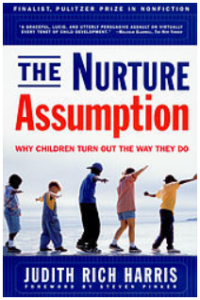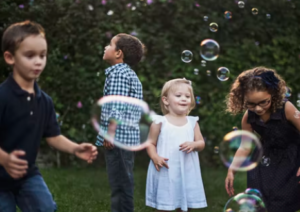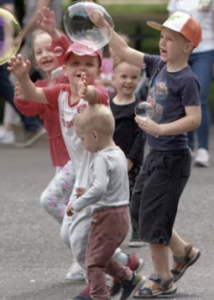by Sue Palmer
 According to new research on the relationship between play and mental health (see September newsletter), ‘children’s social play competences at age 7 significantly predicted lower levels of internalising and externalising problems at age 11’.
According to new research on the relationship between play and mental health (see September newsletter), ‘children’s social play competences at age 7 significantly predicted lower levels of internalising and externalising problems at age 11’.
This pronouncement sent me scurrying to the bookcase for The Nurture Assumption by Judith Rich Harris, to check out something she says about evolutionary biology. It’s this: since human children were reared in tribal societies for upwards of 250 millennia, the child-rearing practices of such societies must’ve had a significant evolutionary impact on human biology.
The evolutionary playgroup
Harris describes how mothers in tribal cultures care for their babies twenty-four hours a day for at least the first two years. Sometime in the third year, the baby would be weaned, often quite abruptly, because mum was pregnant again. When the ‘old baby’ was supplanted by a new baby at the centre of mum’s existence, s/he would be handed over to a ‘playgroup’ of other children.
There’d probably be few children over seven years old in the playgroup because they’d be old and responsible enough to carry out simple jobs for the family and tribe, like watching the cattle or fetching water. So while mums, grannies and aunties would obviously keep a weather eye on them, the three-to seven-year-olds would be reared (for four years which we now know are critical for brain development) by a gaggle of their tribal peers.
 The transition from apple-of-mum’s-eye to lowest-of-the-low in the playgroup would probably be pretty traumatic but, as Harris points out, by this age the drive for social play is extremely strong so there’d be plenty of motivation to learn the ropes. She includes the following quotation from a German ethnologist who studies contemporary tribal societies:
The transition from apple-of-mum’s-eye to lowest-of-the-low in the playgroup would probably be pretty traumatic but, as Harris points out, by this age the drive for social play is extremely strong so there’d be plenty of motivation to learn the ropes. She includes the following quotation from a German ethnologist who studies contemporary tribal societies:
’The older ones explain the rules of play and will admonish those who do not adhere to them … Initially the older children behave very tolerantly towards the younger ones, although eventually they place definite limitations on behaviour. By playing together in the children’s group the members learn what aggravates others and which rules they must obey.’
The nurture of children
The more I learn about the development of socio-emotional skills, the more convinced I am that the three-to-seven age group is primed by evolution to help ‘bring itself up’. Little children in these playgroups learned from the big ones. And the big children honed their capacity for social responsibility by caring for the little ones. It would be quite gratifying for the six-year-olds to have wee apprentices looking up to them – and, of course, if they didn’t perform their caring function with reasonable success, there’d be hell to pay from the mums, grannies and aunties.
Our culture is so far removed from tribal societies that it’s tempting to dismiss such customs as irrelevant. There’s so much for children to learn these days and so many technological shortcuts to information. But as science makes clear, there are no short-cuts in biological development.
 In terms of socialisation, for instance, babies through the ages have learned basic social skills by imitating adult carers but by two or three years old they’re ready to practise the skills with other children during active, social, outdoor play. That’s where they learn how to make friends, avoid enemies, deal with fall-outs, follow rules, communicate about shared projects and discover how best they personally can contribute to the group.
In terms of socialisation, for instance, babies through the ages have learned basic social skills by imitating adult carers but by two or three years old they’re ready to practise the skills with other children during active, social, outdoor play. That’s where they learn how to make friends, avoid enemies, deal with fall-outs, follow rules, communicate about shared projects and discover how best they personally can contribute to the group.
Social skills are, of course, entwined with many other aspects of socio-emotional maturation, such as emotional resilience and the capacity to regulate one’s own behaviour. And they’re all intrinsically linked to physical development, as children learn to control and coordinate their bodies, assess risks in their play and – when this assessment proves wrong – pick themselves up, brush themselves down and become just that little bit more emotionally resilient. All this activity also overlaps with cognitive development, as embodied experiences are turned into abstract memories that can be communicated in words. Development is a holistic process, and we 21st century adults forget that at our peril.
The social advantages of kindergarten
In traffic-clogged 21st century streets, it’s impossible for parents to let the three-to-seven age-group play outdoors alone, so it’s up to the state to make up for the loss. Two hundred years ago, Frederick Froebel provided a wonderful blueprint for early learning and care in his ‘kindergarten’ system but the UK, with its devotion to an early start on formal schooling, has failed to build on this. That’s why Upstart looked north for contemporary models of effective childcare practice.
Re-reading Harris’s book reminded me of my first visit to a Finnish day-care centre. It was back in 2004 when Health & Safety Fever was at its height in the UK so I was astounded that the children were free to play in the extensive outdoor area at any time, with no adult supervision. My Finnish host was bemused by my anxious enquiries. ‘But if there is an accident, the children will tell us,’ she said.
 She also told me there was one rule children must follow before pursuing this outdoor freedom: they had to change into appropriate outdoor clothes (puddle-suits and sturdy footwear) without adult help. For the three-year-olds, this seemed a big ask. But I soon noticed that the older children did the helping.
She also told me there was one rule children must follow before pursuing this outdoor freedom: they had to change into appropriate outdoor clothes (puddle-suits and sturdy footwear) without adult help. For the three-year-olds, this seemed a big ask. But I soon noticed that the older children did the helping.
If Scotland wants its young people to be ‘confident individuals, successful learners, effective contributors and responsible citizens’, we must learn from Froebel, the Finns, and their tribal antecedents. The four Curriculum for Excellence capacities develop, in the early years, through play. And the social side of early play is greatly enhanced by mixed age groups – known in educationese as ‘vertical grouping’.
Kate Johnson and I give some suggestions for facilitating vertical grouping in modern-day Scotland in our chapter in Play is the Way: child development, early years and the future of Scottish education. We’d love to hear from any schools or settings that are experimenting with ways of bringing three- to seven-year-olds together, and thus allowing human biology to weave its ancient magic.



With my primary interest focusing on the social development of children, I must agree with your section of the blog regarding the socialisation and social advantages of children. Your mention of the imitation of adult carers supports Jean Piaget’s theory as he suggests that invisible imitation is a major cognitive milestone that occurs during the end of the sensory-motor stage of cognitive development. Your statement also supports Albert Bandura’s social learning theory in which most human behaviour is conceptualised via observation, imitation, and modelling. Children gain knowledge by mimicking the behavioural patterns they observe in their environment, as well as the interpersonal strategies with whom they mature or engage with (Carlos, 2021).
You have touched upon your encounter of experiencing a foreign outlook on health and safety within childcare settings, and I too would feel the same way you felt when discovering these policies. But, to a certain extent, I understand why the Finnish daycare centre has done this – to promote risky play which is further strengthening the children’s self-reliance and independent skills. I can also understand the rule of the children dressing themselves for outdoor play with no adult help. This is because the action promotes self-awareness of challenges, the concept of basic needs (weather-permitting clothes for warmth) and physical development concerning fine and gross motor skills, flexibility, and strength.
There is the question as to why children support their younger peers in need – is this an additional example of Bandura’s theory by the older children mimicking the actions of their caregivers helping them? Or is it common instinct? Mixed-age play supports Vygotsky’s scaffolding theory. Regarding fun, older individuals instinctually, and frequently unknowingly, erect scaffolds which enable younger children to expand and strengthen their physical, social, and cognitive abilities. Even when they are not engaging with older children, young children gain knowledge by observing and paying close attention to them. Such observations provide children with not only increased knowledge but also inspiration. It is sufficient for younger children to be allowed to interact with older individuals without being coerced to do so. According to research, when granted the opportunity, children frequently choose to play with those their age or younger. They are drawn to this by a genetic predisposition. They are aware deep down that this type of play is particularly enjoyable and advantageous to both the younger and older child (Frisell, n.d.).
I can understand and side with your ‘anxious enquiries’. I must disagree with the Finnish host who said, ‘But if there is an accident, the children will tell us,’ which for me as an HND student currently studying the importance of policy and safeguarding is slightly worrying. If professionals are not present to identify and remove any potential hazards, the children may obtain an injury. Additionally, if a child were to suffer a severe injury and needed medical attention because there was no supervision to keep them safe, it would fall back on the staff, and they would suffer major consequences.
Conclusively, we in Scotland perceive leaving children outdoors unattended to be dangerous for children’s health and safety, but the Finnish will see this as the best way for children to gain independence and discover risks on their own. In that case, we need to question if we wrap our children in cotton wool and shield them from the dangers and risks they will face one day anyway? Do we need to let our children be more individual and self-reliant without having so much guidance from adults in their environment? As previously mentioned, if children notice a younger child needing assistance their instinct is to help them, so why should we as professionals need to step in if a child’s peers can do the same job and strengthen both their social, emotional, physical and cognitive developments?
REFERENCES
Frisell, C., n.d. Mix It Up. [Blog] Mixed-Age Play Is Good for Kids, Available at: [Accessed 22 September 2022].
Meltzoff, A. and Williamson, R., 2017. Imitation and Modelling. 1st ed. [eBook] Seattle, WA, United States: Elsevier Inc., pp.2, 3, 4. Available at: [Accessed 18 September 2022].
Carlos, 2021. [Blog] Why Do Children Imitate Adults?, Available at: [Accessed 18 September 2022].
Thanks very much indeed for adding these thoughts. When I was a young teacher in the 70s, vertical grouping was quite common in the early part of the primary school, and I was lucky enough to teach in a small country school where there were several year groups in each class. So the evolutionary theory I described in the blog made complete sense to me. It’s great that you’ve been researching the subject.
Maybe one day, Scotland will be as enlightened as Finland in the way we care for and educate the under-sevens…